Scottish Health Survey - topic report: physical activity
This report presents findings from a study into the demographic, socioeconomic and health and lifestyle factors associated with meeting the adult physical activity guidelines in the Scottish population and whether the change in physical activity guidelines in 2011 affected the factors associated with meeting the guidelines. It also presents results from an investigation in to the factors associated with taking part in activity in the different domains that make up total physical activity.
4. Results - Bivariate Associations with Physical Activity
4.1 Meeting physical activity guidelines
Of the sample of 4807 adults, 62% met the recommended physical activity levels in 2012. Just over a fifth (21%) of adults had very low activity levels, participating in 30 minutes or less total physical activity per week, see Figure 2.
Figure 2: Population physical activity levels, 2012
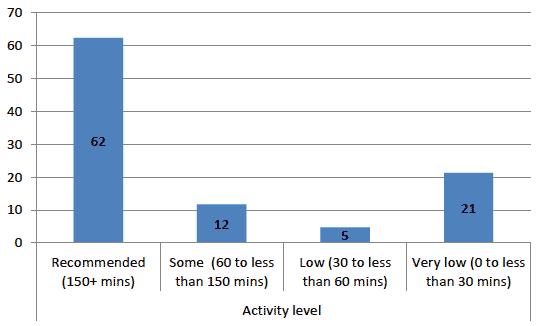
Figure 3 illustrates the proportion of physical activity taking place across the five domains of activity: at work, housework, manual/gardening/DIY work, walking and sports and exercise.
Figure 3: Participation in any physical activity by domain, 2012 (percentage of total hours, all respondents)
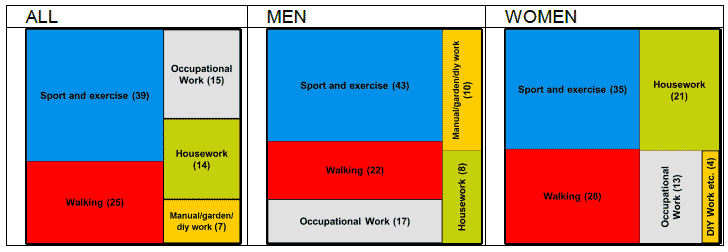
In 2012, physical activity in the domain of sport and exercise was proportionately the largest contributor to total physical activity (39%), followed by walking (25%). Sport and exercise remained the largest contributor to total physical activity for men, however, sport and exercise and walking were equal contributors for women. For women, housework contributed more than occupational physical activity and was the third largest contributing domain (24%). Housework was less of a contributor to men's total physical activity. For men, occupational physical activity was third after sport and exercise and walking. When analysis was carried out on only those who met the guidelines, there was virtually no difference in the results.
Demographic Factors
All demographic factors were shown to be significantly associated with physical activity in the bivariate analyses:
Sex - More men than women reached the recommended physical activity levels in Scotland in 2012 (67% v 58%), see Figure 4.
Age - The analysis demonstrated a decline in achieving physical activity recommendations with increasing age. Amongst adult age groups in Scotland, the decline starts around age 45 and there is a further sharp decline at age 75 or over, see Figure 5. The age pattern is somewhat different for men and women, see Figure 6. The decline in men is fairly steady with age, whereas for women the proportion meeting the guidelines is fairly consistent until age 55. Both men and women experience a sharp drop from age 75. The gap between those in the younger age band and those ages 75+ is 50 percentage points (75% v 25%).
Marital status - There was no significant difference between the first four categories (married/civil partnership, living as married, single and separated). There was a significant difference compared to these four categories with a divorced/dissolved or widowed/surviving status. However, the majority of those who are widowed/surviving are aged at least 65, hence would be expected to have a lower rate of achieving the recommended physical activity level associated with their age.
When separate analyses were done by sex, the only significant difference was between men who were married (67%) and men who are co-habiting as though married (79%), see Figure 7.
Figure 4: Proportion meeting the recommended physical activity levels by sex, 2012
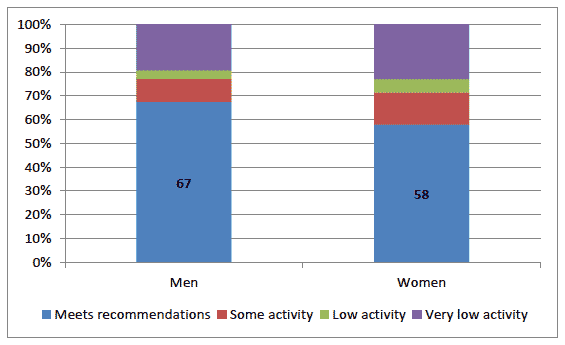
Figure 5: Proportion meeting the recommended physical activity levels by age, 2012
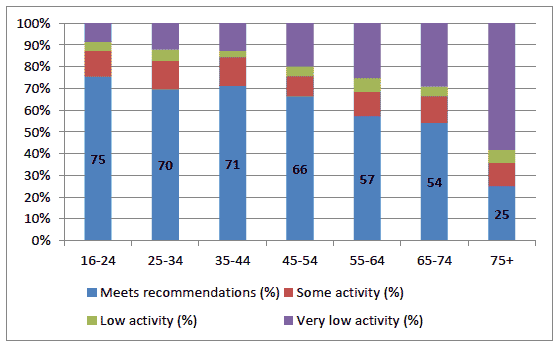
Figure 6: Proportion meeting the recommended physical activity levels by sex and age, 2012
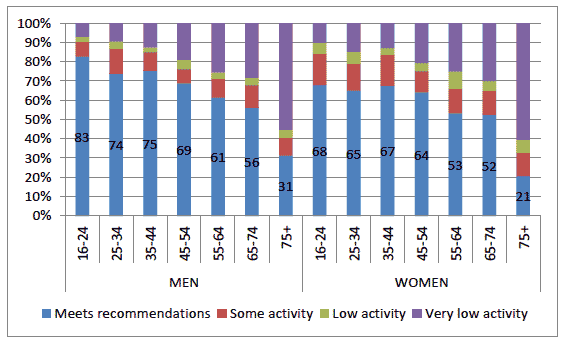
Figure 7: Proportion meeting the recommended physical activity levels by marital status, 2012
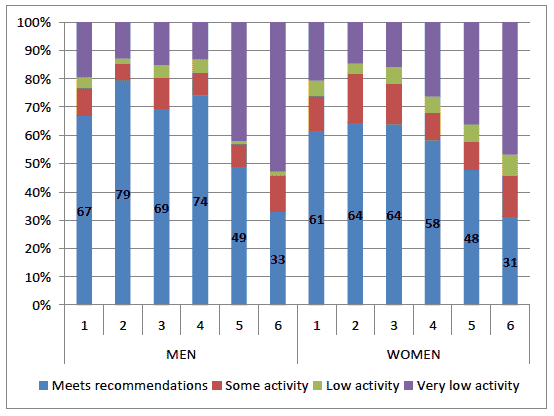
1-Married/civil partnership; 2-Living as married; 3-Single; 4-Separated; 5-Divorced/dissolved; 6-Widowed/surviving
Socioeconomic factors
All socioeconomic factors were shown to be significantly associated with physical activity in the bivariate analyses:
Income level - In 2012, there was a significant difference between those in the highest equivalised income band and those in the lower three income bands. There was no significant difference between the three lowest income bands. Three quarters (74%) of adults with an equivalised income of at least £39520 reached the recommended physical activity level compared to just under 50% of those with an equivalised income of less than £10672.
For both men and women, the trend was the same - the proportion of those reaching the recommended physical activity level tended to increase with increase in equivalised income. More men than women reached the recommended level in each of the income bands except the lowest income quintile; 79% of men and 67% of women in the highest income quintile compared to 49% of men and 50% of women in the lowest equivalised income group, see Figure 8. The decline in meeting activity recommendations with decreasing income is accompanied by a corresponding rise in inactivity (rather than 'some' or 'low' activity).
Area deprivation - As area deprivation increases, the proportion of adults reaching the recommended physical activity levels decreases. Nearly 80% of those in the least deprived quintile reached the recommended physical activity level compared to just over 54% in the most deprived quintile. There was a significant difference between the least deprived quintile and the 1st, 2nd and 3rd most deprived quintiles.
For men the same general trend was found with a significant difference between the most deprived quintile and the three least deprived quintiles. There was a 21 percentage point gap in men's physical activity levels between those in the least deprived and most deprived quintiles (77% v 56%). The relationship was less stark, though still apparent for women, with a 14 percentage point difference in women's activity levels between those in the least deprived and most deprived quintiles (66% v 52%), see Figure 9.
Economic activity status - While no significant difference was found between students and those in paid work, the rest of the categories (unemployed/unable to work/retired/looking after family/other) were found to have significantly lower proportions meeting the physical activity recommendations. Full time students and those in paid work had the highest rate of meeting the recommended physical activity levels (77% and 75%) compared to 58% of those unemployed and 15% of those unable to work, see Figure 10.
Education - The only notable variation of physical activity by education was significantly lower levels of activity amongst those with either no qualifications or those with other school level qualifications compared to those with at least standard grade qualification and above, see Figure 11.
Figure 8: Proportion meeting the recommended physical activity levels by sex and equivalised income, 2012
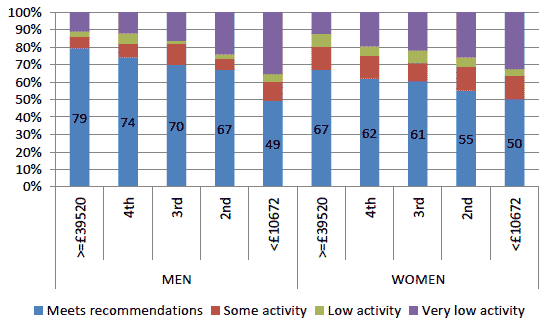
Figure 9: Proportion meeting the recommended physical activity levels by sex and area deprivation, 2012
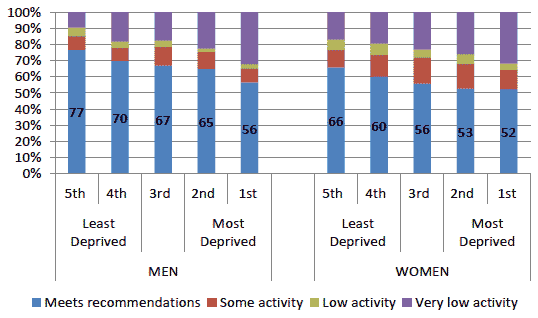
Figure 10: Proportion meeting the recommended physical activity levels by economic activity status, 2012
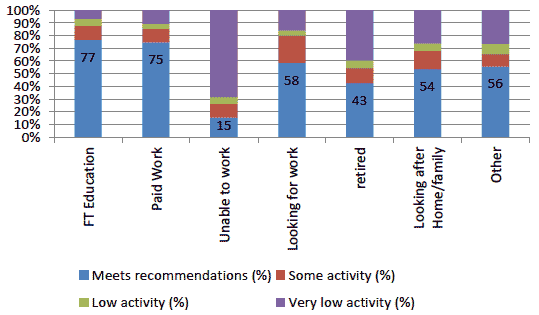
Figure 11: Proportion meeting the recommended physical activity levels by highest education qualification, 2012
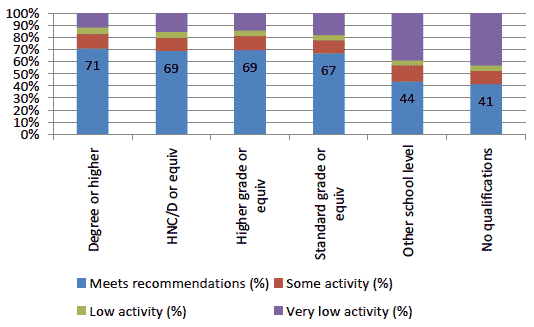
Health and lifestyle factors
All health and lifestyle factors were shown to be significantly associated with physical activity in the bivariate analyses:
Self-assessed health - There is a steep and linear decline in physical activity levels as self-assessed health declines from very good to very bad. For all adults, 71% of those who reported very good or good health reached the recommended physical activity levels compared to only 20% of those reporting bad or very bad health. The pattern was similar for men and women: 76% of men and 67% of women who reported their health as very good or good reached the recommended physical activity levels, while only 19% of men and 21% women reporting bad or very bad health did so, see Figure 12.
Disability - The proportion of adults meeting the recommended physical activity guidelines decreased as self-report of long term limiting illness increased. For all adults, 74% of those with no disability reached the recommended physical activity guidelines compared to 41% of those with a long term limiting illness. A similar pattern was observed in both men and women, see Figure 13.
BMI - Adults with a high BMI (30 and over - obese) were significantly less likely to meet physical activity recommendations (54%) compared to those classified as having a normal BMI (18.5-25) or who were overweight (25-30) (69%). The pattern was more pronounced in men than women, see Figure 14.
Smoking - A significant difference was found between those who have never smoked and either ex-smokers or current smokers. A higher proportion of those who have never smoked met the physical activity recommendations (67%) compared to ex-smokers (59%) and current smokers (57%). A similar pattern was found for men and women, see Figure 15.
Mental well-being - Adults with a mean or higher WEMWBS score (higher mental wellbeing) were significantly more likely to meet the recommended physical activity level (67%) than those with a low WEMWBS score (37%). This pattern was similar between men and women: 73% of men and 62% of women with a high WEMWBS score reached the recommended level, while only 59% of men and 50% of women reporting a low WEMWBS did so, see Figures 16.
Life satisfaction - The analysis showed that a higher score for life satisfaction was associated with meeting the recommended physical activity levels. Of those with low life satisfaction (scores 0-7), 54% met the recommended physical activity levels compared to 70% of those reporting high life satisfaction (scores 8-10). Similar patterns were seen for men and women, see Figure 17.
Figure 12: Proportion meeting the recommended physical activity levels by sex and self-assessed health, 2012
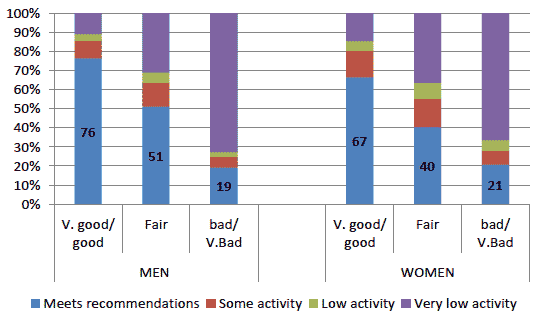
Figure 13: Proportion meeting the recommended physical activity levels by sex and disability, 2012
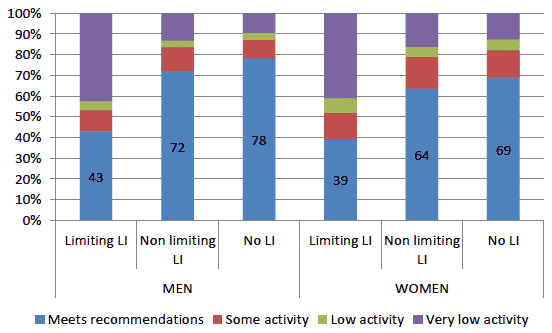
Figure 14: Proportion meeting the recommended physical activity levels by sex and BMI, 2012
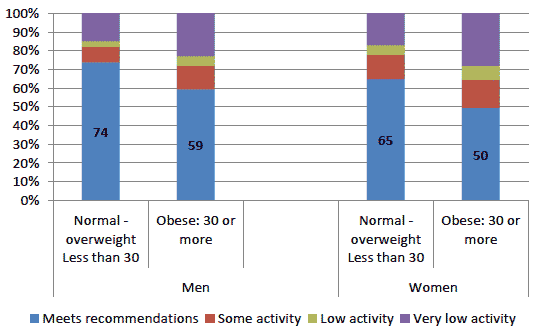
Figure 15: Proportion meeting the recommended physical activity levels by sex and cigarette smoking, 2012
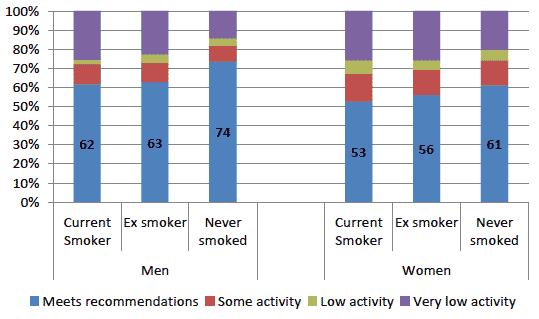
Figure 16: Proportion meeting the recommended physical activity levels by sex and mental wellbeing (WEMWBS score), 2012
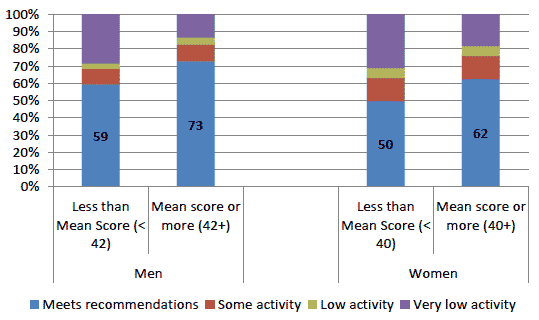
Figure 17: Proportion meeting the recommended physical activity levels by life satisfaction score, 2012
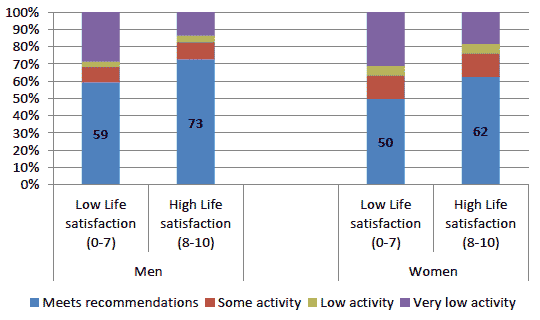
This chapter has presented the results of the bivariate analysis of factors correlated with meeting the physical activity guidelines in 2012. It is likely there are many inter-relationships between the variables above, for example, age is likely to partly explain the lower rates of married men meeting the physical activity guidelines compared to co-habiting men. The advantage of conducting logistic regression is that these inter-relationships between independent variables are accounted for, and so a more meaningful explanation of the factors that predict meeting the guidelines can be produced. The results of this logistic regression are presented in the following chapter.
Contact
Email: Niamh O'Connor
There is a problem
Thanks for your feedback